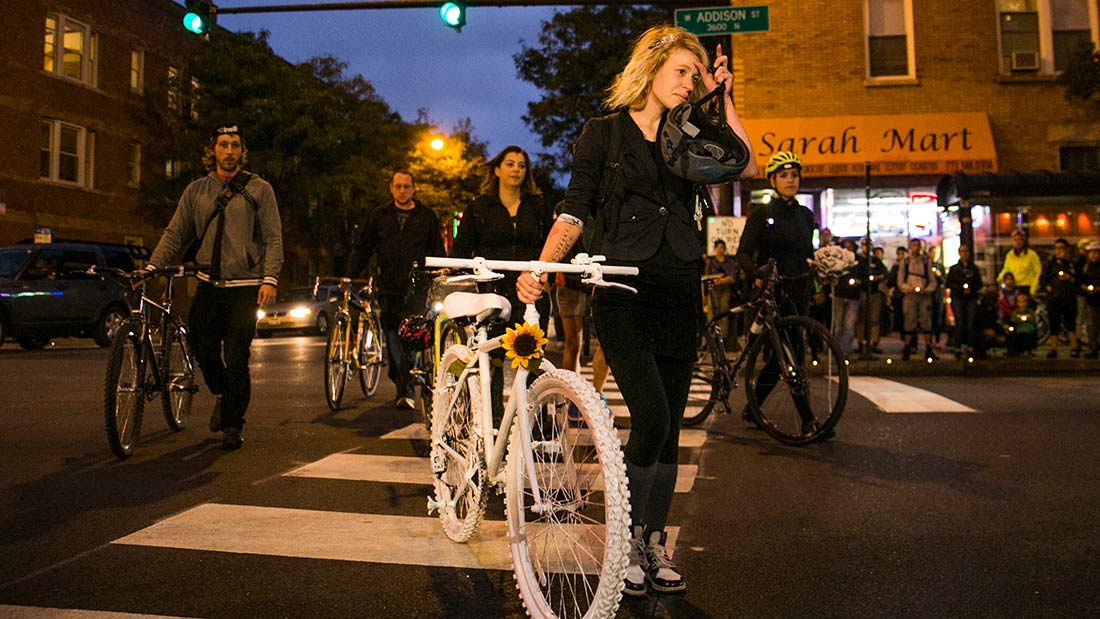By Patricia Nabong
Anastasia Kondrasheva was cycling to work on Damen Avenue when a flatbed truck driving on her left turned right as she was also turning, and hit her.
Twenty-three-year-old Kondrasheva was the sixth cyclist killed by a commercial vehicle in Chicago this year, according to Streetsblog Chicago which regularly monitors road accidents. The casualty occurred just a week after Chicago was named the best bike city in the U.S. by Bicycling magazine.
Demands for safer streets are getting louder.
—–
For related stories, see Divvy Bikes: a safe way to get around Chicago by Caroline Kenny and Cyclists group urges more women to hit the road by Sophie Zhang
—–
“We have to make street safety a priority,” said Rebecca Resman, an organizer at Kidical Mass Chicago, during Kondrasheva’s memorial Sept. 30, which drew hundreds of cyclists and road safety advocates.

“This isn’t a cycling community problem. This isn’t a problem for the pedestrian community. This isn’t a problem for people that drive. This is everybody’s problem, and we need to work together to solve it.”
Safer streets for everyone
In light of recent events, the Active Transportation Alliance, which has worked with the city on various transportation-related ordinances, released a petition, which aims to eliminate accidents caused by trucks and other commercial vehicles.
The petition requests that concerned government agencies “enhance commercial vehicle regulation, reduce dangerous speeding, restrict right turns in dangerous locations, expand education for all, improve our infrastructure and street design and fairly enforce traffic laws.”
“Larger commercial vehicles have more blind spots, making it difficult to see people walking and biking,” said Ted Villaire, communications director of the alliance. “Also, they [commercial vehicles] are higher up, so it’s more possible for [bikers] to get caught under the tires.”
The city has reviewed the petition and will work together to reduce accidents through improved infrastructure and education. This is part of Vision Zero, launched by Mayor Rahm Emanuel Sept. 6, which is a “data-driven, multi-agency” plan that aims to reduce accidents with the goal of “eliminating traffic fatalities and serious injuries in Chicago by 2026.”
“Due to the larger size of trucks, anyone operating a truck or larger vehicle has an extra responsibility to be cautious and careful on city streets, especially when executing a turning movement,” said Claffey. “We recommend wearing bright clothing and a helmet for added safety, and if you are biking at night, you are required to have lights on your bike.”
Infrastructure is the bare minimum
Chicago now has more than 200 miles of bike paths, including buffered, shared, protected and off-road lanes, according to the Chicago Streets for Cycling Plan 2020. Infrastructure is increasing as the city aims to finish constructing 645 miles of bike lanes.
Despite this, with six cyclist casualties, the total number of accidents that occurred in the first nine months of 2016 has already caught up with the number of fatalities in 2014. According to the Illinois Department of Transportation, six cyclists were killed in Chicago in 2014; three were killed in 2013.
To some cyclists, infrastructure is not enough to prevent accidents. Many accidents are caused by motorists who text and drive, don’t signal their intentions, drive on bike lanes and don’t watch out for cyclists before opening their doors, according to Brian Marquis, Maureen Gallagher and Kristen Green, all of whom have been commuting by bike in Chicago for years.
While many cyclists are pressuring drivers to become more aware on the road, they are also encouraging bikers to do their part.
“If you’re a cyclist, it’s not just about wearing a helmet,” said Green, founder of Ghost Bikes Chicago, an organization that installs the white bikes, in intersections where cyclists have been killed. “It’s about being a safe and predictable rider. And the same things apply to drivers.”
Save
Save
Save
Save

